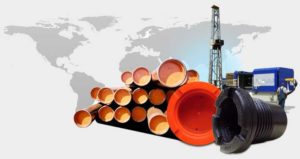No matter which model of rod pump you use, the sucker rod string selection and design greatly influence the yield from the well. As the sucker rod transfers the hammer action’s energy to the downhole pump, stress and pressure can cause different failures. Ultimately, this can reduce the production quantity. To ensure operations remain optimized, producers need sucker rod protection. During handling and storage, the protection has to consistently cover each segment and component that make up the string.
Energy consumption continues to increase year on year. To capitalize on the growing demand, operators should avoid well failures at all times. Running a sucker rod string is a timely and complex process, made worse when service members have to pull and change out any one of the components. For the latest dynamic news and information on energy and pipe equipment, see World Pipelines.
The Primary Components of a Sucker Rod Pumping Rig
While the configuration of rigs has evolved since the 1920s, the primary components remain relatively unchanged. Every rod pumping rig uses a prime mover with a horse and hammer section that connects the rod string to the downhole pump. The maximum travel of the hammer determines the yield using a traveling and static valve situated at a specific depth. On the upstroke, the traveling valve opens and collects the hydrocarbons, while the downstroke seals the pump and forces fluids up the well’s casing tube.
Although the travel of the hammer correlates to the movement of the traveling and static valves in the pump, the rod string stretches under tensile pressure. The increase and decrease in the rod string length influence the opening and closing of the pump, thereby influencing its total capacity.
As there is no way to inspect the downhole components visually without pulling the string, operators need to ensure every sucker rod and coupling remains protected before running them down the well. Failure to do so can result in tensile or fatigue failures. If production drops in a particular well, teams often assume the problem resides with the downhole pump. It may point either to a faulty seal or gas buildup in the pump, but the wave traveling down the string could also be the primary cause.
Rod String Components
The design of the sucker rod string depends mainly on the size and depth of the well. To make up the string, sucker rod sections of 25 feet interconnect with couplings, with a pony rod at the top connecting to the polished rod at the cap of the well. Each component and its connection needs persistent protection against mechanical damage to the threaded parts and corrosion prevention during storage and handling.
Common Types of Sucker Rod Failures
For wells with a high failure frequency rate, it could point to inadequate protection during handling and storage of the sucker rod string’s components. All failures with sucker rods, pony rods, and couplings point to tensile or fatigue problems with the string.
Tensile failures happen when the load applied to the rig exceeds the rated strength of the rods. With tensile failures, the load will concentrate at a specific point in the string, causing a necked-down visual indication around the circumference of the rod. This only occurs when pulling an excessive load on the total string. To avoid these failures, the load should never exceed 90% of the rated amount for a new sucker rod.
Fatigue failures are more common in sucker rod strings and occur for several different reasons. They can start as minor stress fractures or corrosion build up during use and usually progress quickly. This is due to the distribution of load along the entire cross-section. Pumpers can identify these types of failures with visual inspections for beach or ratchet marks before a catastrophic failure occurs.
Types of fatigue failures include:
- Casehardened failure
- Torsional failure
- Surface Damage Failures
- Connection Pre-load Failures
To prevent fatigue failure frequency rates, every sucker rod string’s components need persistent protection before installation. For the best results, you’ll need to use caps that seal the threaded parts whenever you pull the string.
MSI’s Durable Range of Sucker Rod Protection Equipment
MSI’s range of sucker rod protectors is easy to install and remove. Moreover, we manufacture every cap or plug with HDPE for the best durability. The caps provide maximum impact protection, crack prevention, and thread coverage. The plugs ensure no debris build-up for couplings and provide complete thread protection before installation.
When protecting your OCTG and sucker rods, we have the production capacity and design capability to manufacture according to the highest quality standards and volumes.
Overall, there are a few reasons why we keep our standards high:
- First, your safety and peace of mind remain our top priority.
- Second, we aim to ensure that your sucker rod equipment remains safeguarded, even during transportation and storage.
- Lastly, we’ll continue helping your operations run as smoothly as possible with equipment that has its integrity intact.
Helping You Deliver
With regular price fluctuations in the oil and gas industry, remaining profitable requires maintaining your assets for the maximum lifespan. At MSI Pipe Protection Technologies, we understand that any sucker rod failure can be catastrophic for operations.
To start increasing the lifecycle of your rods and couplings, speak to one of our service experts today. You may also contact us toll-free at 1-877-276-9208.




